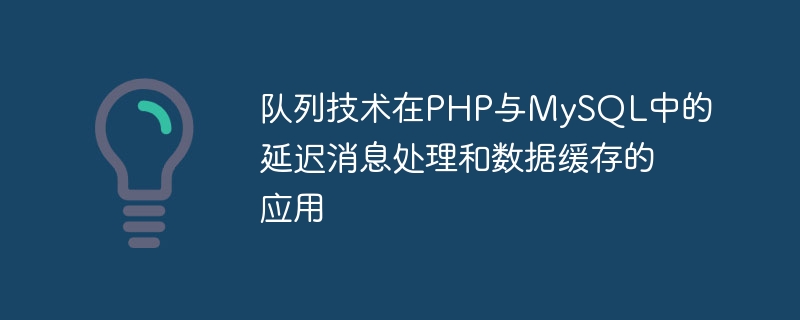Home >Backend Development >PHP Tutorial >Application of queue technology in delayed message processing and data caching in PHP and MySQL
Application of queue technology in delayed message processing and data caching in PHP and MySQL
- WBOYWBOYWBOYWBOYWBOYWBOYWBOYWBOYWBOYWBOYWBOYWBOYWBOriginal
- 2023-10-15 08:03:111602browse

Application of queue technology in delayed message processing and data caching in PHP and MySQL
Introduction: With the rapid development of the Internet, the demand for real-time data processing is increasing high. However, traditional database operation methods often cause performance bottlenecks when processing large amounts of real-time data. In order to solve this problem, queue technology came into being, which can help us implement asynchronous processing of data and improve system performance and response speed. This article will introduce the application of queue technology in delayed message processing and data caching in PHP and MySQL, and illustrate it through specific code examples.
1. Introduction to queue technology
Queue is a first-in-first-out (FIFO) data structure that can store and manage multiple tasks or messages. Queue technology implements asynchronous processing of tasks by putting tasks or messages into a queue, then taking them out of the queue and processing them. Queuing technology excels at enabling delayed message processing and data caching.
2. Delayed message processing
Delayed message processing refers to temporarily storing some tasks or messages that need to be executed at a certain point in the future in the queue and waiting for a specified time before processing. This approach can reduce the burden on the system and provide a better user experience.
In PHP, we can use Redis as a queue service and combine it with scheduled tasks to implement delayed message processing. The following is a specific sample code:
// 1. 连接Redis
$redis = new Redis();
$redis->connect('localhost', 6379);
// 2. 将延迟消息放入队列中
$task = [
'message' => 'Hello, delayed message!',
'execute_at' => strtotime('+10 minutes') // 十分钟后执行
];
$redis->zAdd('delayed_queue', $task['execute_at'], json_encode($task));
// 3. 定时任务处理延迟消息
while (true) {
$tasks = $redis->zRangeByScore('delayed_queue', 0, time());
foreach ($tasks as $task) {
$task = json_decode($task, true);
// 处理延迟消息
processDelayedMessage($task['message']);
// 从队列中移除已经处理的任务
$redis->zRem('delayed_queue', json_encode($task));
}
sleep(1); // 每隔一秒检查一次延迟队列
}
// 处理延迟消息的逻辑
function processDelayedMessage($message) {
echo $message . PHP_EOL;
}In this example, we use Redis's ordered set (sorted set) as a delay queue, and store tasks that need to be delayed in the form of JSON strings in the queue. , and set the execution time of the task. Then, the scheduled task checks the queue every second to find the tasks that need to be executed and processes them.
3. Data caching
Data caching refers to storing some frequently accessed data in the cache to reduce frequent access to the database and thereby improve system performance. In PHP, we can use Memcached or Redis as a cache service, combined with queue technology to implement data caching.
The following is a sample code that uses queue technology to implement data caching:
// 1. 查询缓存
function queryCache($key) {
// 查询缓存
$cacheData = getCacheByKey($key);
if ($cacheData !== false) {
return $cacheData;
}
// 如果缓存不存在,则从数据库中查询
$data = fetchDataFromDatabase($key);
// 将查询结果存入缓存
setCacheByKey($key, $data);
return $data;
}
// 2. 获取缓存数据
function getCacheByKey($key) {
$redis = new Redis();
$redis->connect('localhost', 6379);
return $redis->get($key);
}
// 3. 将查询结果存入缓存
function setCacheByKey($key, $data) {
$redis = new Redis();
$redis->connect('localhost', 6379);
$redis->set($key, json_encode($data));
}
// 4. 从数据库中查询数据
function fetchDataFromDatabase($key) {
// 从数据库中查询数据的逻辑
}In this example, we use Redis as a cache service and obtain and store cached data through the getCacheByKey and setCacheByKey methods . First, we query the data from the cache. If it exists in the cache, we directly return the cached data; if it does not exist in the cache, we query it from the database and store the query results in the cache.
Conclusion:
The application of queue technology in PHP and MySQL can help us implement delayed message processing and data caching, thereby improving system performance and response speed. Delayed message processing can temporarily store some tasks that need to be executed at a certain point in the future in the queue and wait for a specified time before processing; data caching can store some frequently accessed data in the cache, reducing the impact on the database. Visit frequently. In specific implementation, we can use Redis as a queue service and cache service, and combine scheduled tasks and caching technology to complete the corresponding functions. The application of these technologies can significantly improve system performance and user experience.
The above is the detailed content of Application of queue technology in delayed message processing and data caching in PHP and MySQL. For more information, please follow other related articles on the PHP Chinese website!
Related articles
See more- How SpringBoot integrates Redis to implement hotspot data caching
- Examples of message queue technology in PHP and its application in the framework
- Swoole Advanced: How to Design Data Cache Efficiently
- How should data caching, result caching, and page caching be used in Golang?
- Data caching and cache management of PHP and mini programs

